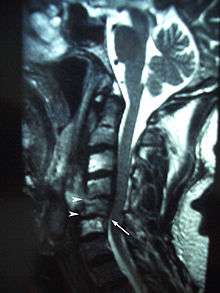Osteoradionecrosis

Osteoradionecrosis is a possible complication following radiotherapy where an area of bone does not heal from irradiation. Irradiation of bones causes damage to osteocytes and impairs the blood supply.[1] The affected hard tissues become hypovascular (reduced number of blood vessels), hypocellular (reduced number of cells) and hypoxic (low levels of oxygen). Osteoradionecrosis usually occurs in the mandible, and causes chronic pain and surface ulceration. Prevention of osteradionecrosis is part of the reason all teeth of questionable prognosis are removed before the start of a course of radiotherapy.[2]
Osteoradionecrosis of the jaw is a significant complication of radiotherapy for oral cavity cancer. In addition to antibiotic medication, treatment options such as hyperbaric oxygen therapy, surgical approaches, and combined therapy with pentoxifylline and tocopherol have been introduced. [3]
References
- ↑ Wray D. Textbook of general and oral surgery. 1st ed. Edinburgh: Churchill Livingstone; 2003.
- ↑ Bouquot, Brad W. Neville, Douglas D. Damm, Carl M. Allen, Jerry E. (2002). Oral & maxillofacial pathology (2. ed.). Philadelphia: W.B. Saunders. p. 263. ISBN 0-7216-9003-3.
- ↑ Fan, Huan; et al. (September 29, 2014). "New approach for the treatment of osteoradionecrosis with pentoxifylline and tocopherol". Biomaterials Research. 18 (13). doi:10.1186/2055-7124-18-13. PMC 4552457. PMID 26331064. Retrieved May 4, 2017.
text imported under the CC-by license, v4